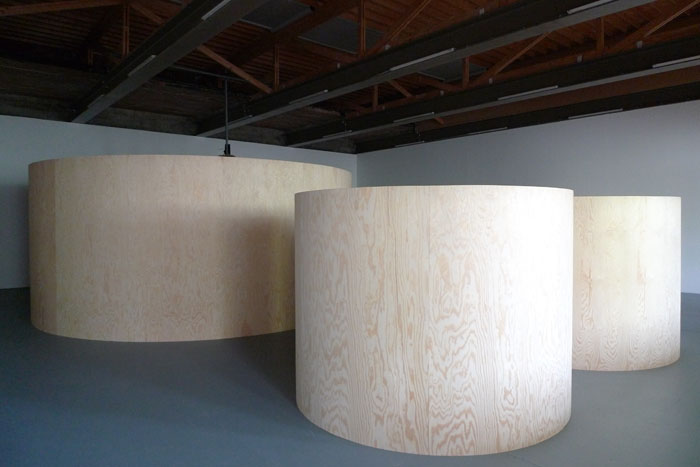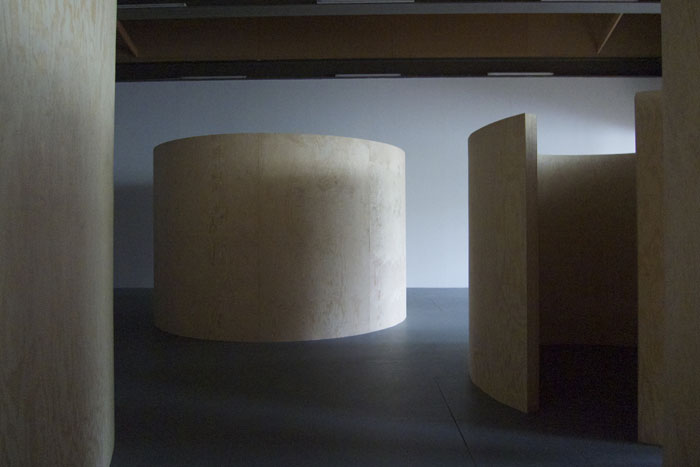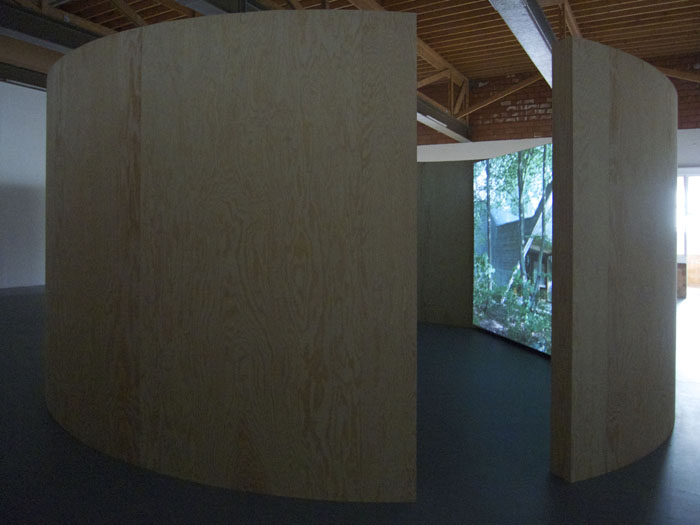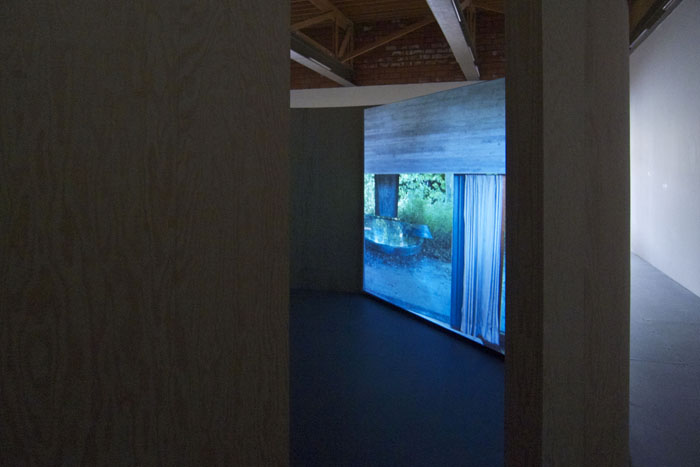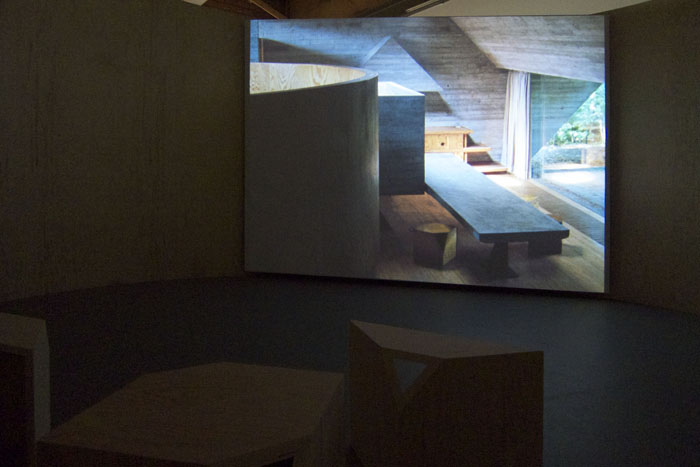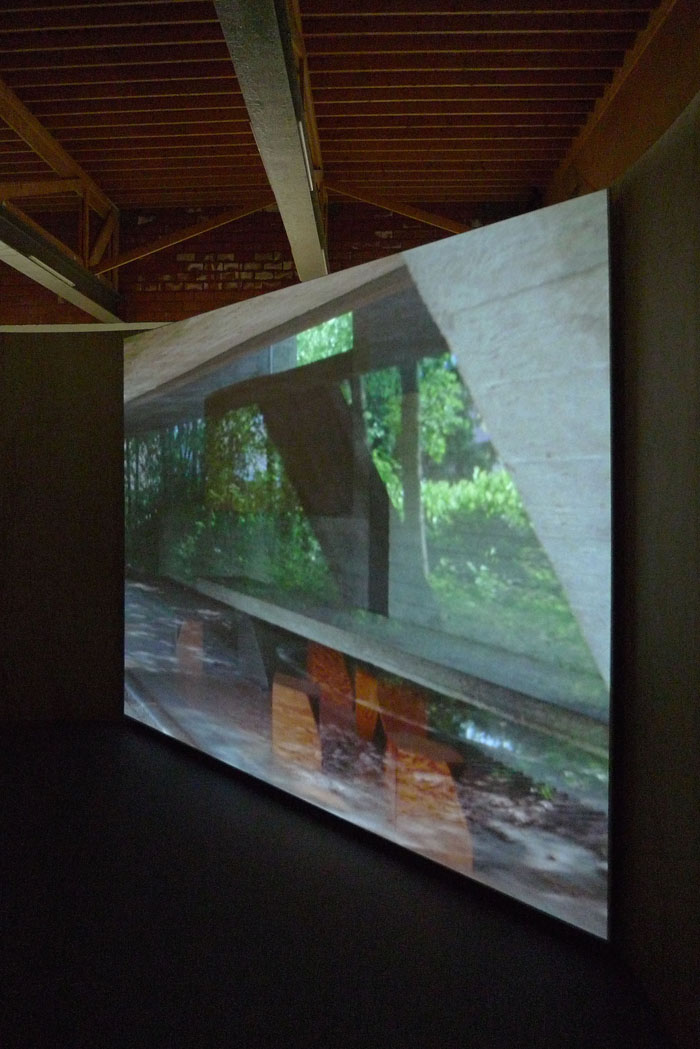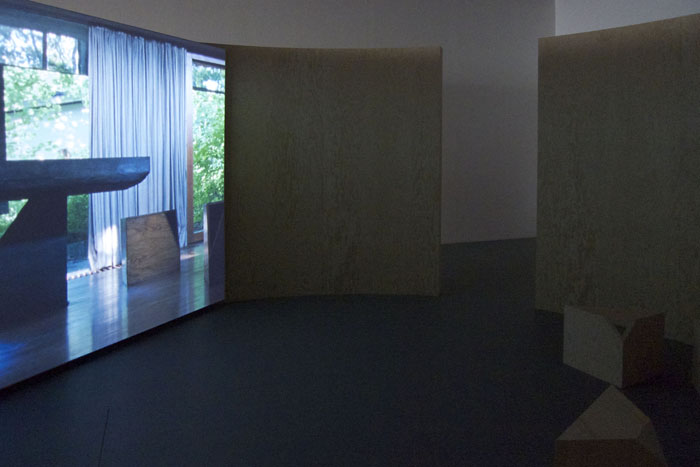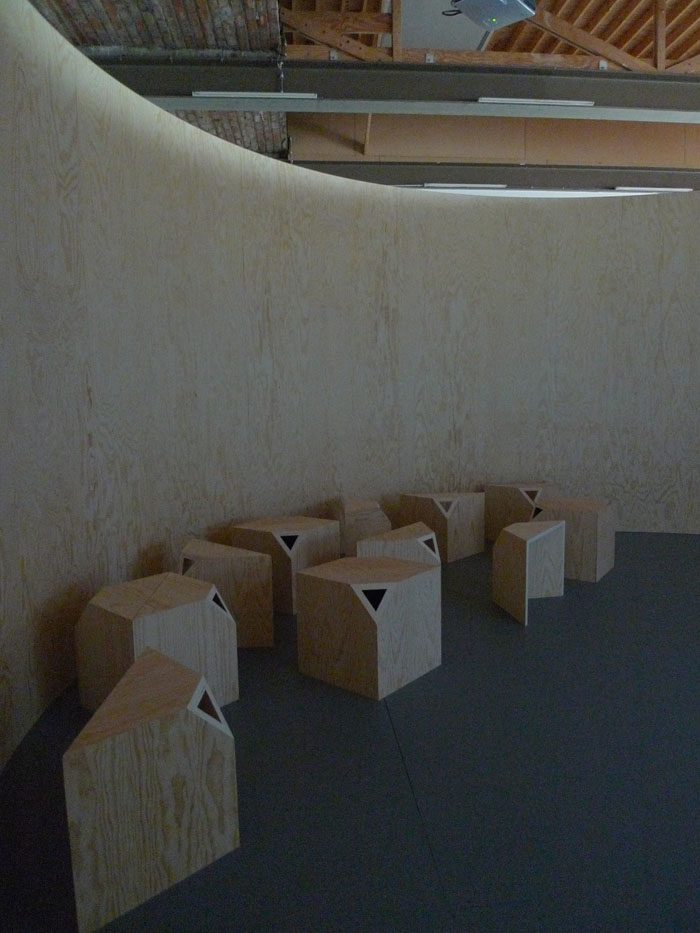Press release :
The oeuvre of the Brussels-based artist Aglaia Konrad (°1960 Salzburg) – comprising photos, films, spatial installations and publications – is characterised by a patent love of architecture. Fuelled by her fascination for the way models and ideas come to be materialised in the constructed world, she conducts her own unconventional visual research into the observation and experience of architecture. Her new film, Das Haus, is a key work in a greater installation that, typically of her approach, has been designed specifically for the exhibition space. This work fits into her series of 16mm films, Concrete & Samples, in which Konrad investigates the sculptural potential of architecture and visualises the sublime and sensual experience of observing it. Das Haus was filmed in and around the Van Wassenhove house in Sint-Martens-Latem – an idiosyncratic, modernist design from 1974 by architect Juliaan Lampens. After the owner recently passed away, the house was gifted to the Department of Architecture & Urban Planning at the University of Ghent, which will be responsible for the further use and management of the former residential home. This transitional moment in the building’s history provides the ideal context for the filming of this unconventional house.
The specific qualities of the medium of film, and in particular the materiality and tactility of 16mm film, allow for the visualisation of the complex interplay of materiality, light, rhythm and movement. The lack of an established formula for an experience-based approach to the visual representation of architecture affords each new work by Konrad a new intensity and tension. The effect of this is constructive, given that the physical architecture in this case forms the unique schematic for the filming process. The compositions are determined by decoding the elements contained by this schematic: the floor plan, use of materials, of light, form, rhythm, etc. The compositions are always influenced by the movement of the recordings and the passing of time, the context and the current status of the building. As a result of this, the outcome of the work cannot be determined or predicted beforehand, which makes this an especially challenging way of working.
An intensive period of on-location research and exploration precedes the actual filming. This is a fundamental phase of concentrated ‘thinking-by-looking’ in which the schematic is studied by the artist. The stylistic choice to use 16mm film is also part of this. The medium must be used economically, which further focuses the artist’s consideration of the experience of observation and the mental pre-selection of images.
Other conscious decisions include the omission of sound and the choice not to include any human presence in the film. This has the effect of making the architecture itself the sole protagonist. The lack of any distracting elements allows the immutable material of the architecture to act and move like a living character. The characterful Van Wassenhove house is notable for its striking concrete forms and its open-plan interior landscape spanning two levels. In the filmic representation of the observational experience we are presented with an extremely intimate picture of the radical choices and poetic gestures made by the architect. The boundless play of natural light and the use of materials in the building is strongly accentuated and brought into the exhibition space. The seating and the cylindrical forms that make up the spatial installation refer graciously to the creations of Juliaan Lampens and their sculptural potential.
Das Haus was produced by August Orts, in cooperation with Courtisane and with additional support from VAF, Netwerk / centre for contemporary art, UGent (Dept. of Architecture & Urban Planning, Dept. of Communication, Dept. of Services), LUCA Sint-Lukas Brussel, Juliaan Lampens Foundation, Fotohof Salzburg and the Province of East Flanders.
The scenography of the presentation was designed by the artist in collaboration with the architect Kris Kimpe.
L’œuvre de l’artiste Aglaia Konrad (°1960 Salzbourg), installée à Bruxelles, comprend photos, films, installations spatiales et publications, et manifeste son amour de l’architecture. Fascinée par la façon dont les modèles et les idées se matérialisent dans le monde bâti, elle mène une recherche visuelle peu conventionnelle sur l’observation et l’expérience de l’architecture.
Son nouveau film, Das Haus, est l’œuvre clé d’une installation plus vaste qui, comme c’est souvent le cas chez Konrad, a été conçue spécialement pour l’espace d’exposition. Ce travail s’insère dans une série de films 16mm, Concrete & Samples, dans laquelle l’artiste explore le potentiel sculptural de l’architecture et se met en quête de formes susceptibles de rendre le sublime et l’expérience sensuelle de l’observation de celle-ci. Das Haus a été filmé autour et à l’intérieur de la maison Van Wassenhove à Sint-Martens-Latem – un cas particulier de l’architecture moderniste imaginé par Juliaan Lampens en 1974. Peu après la mort récente du propriétaire, la maison a été léguée au Département de l’Architecture et de l’Urbanisme de l’Université de Gand, désormais responsable de cette ancienne villa résidentielle. Ce moment de transition dans l’histoire du bâtiment fournit un contexte idéal pour filmer cette demeure inhabituelle.
Les qualités spécifiques du médium filmique, et en particulier la matérialité, la tactilité du film 16mm, permettent de rendre compte d’une interaction complexe de la matière, de la lumière, du rythme et du mouvement. Rares sont les représentations visuelles de l’architecture fondées sur son expérience sensible, ce qui donne au travail de Konrad une intensité particulière ; c’est en effet sur l’architecture physique que repose l’unique schéma du processus filmique. Les cadrages sont déterminés par le décodage des éléments contenus dans ce schéma : le plan d’architecture, l’utilisation des matériaux, la lumière, la forme, le rythme, etc. Ils sont influencés par les mouvements de la caméra, mais aussi par le passage du temps, par le contexte et le statut actuel du bâtiment. Le résultat ne peut jamais être prévu ou déterminé à l’avance, ce qui rend la façon de travailler particulièrement audacieuse.
La réalisation est précédée d’une période intense de recherche et d’exploration sur place, phase fondamentale dans une « pensée par observation » où le schéma de réalisation est longuement médité par l’artiste. Le choix stylistique du film 16mm participe de cette éthique de travail : le médium doit être utilisé avec économie, ce qui impose la pré-sélection mentale des images et une extrême concentration sur l’expérience de l’observation. La suppression du son et le choix de n’inclure aucune présence humaine sont d’autres décisions conscientes, qui font de l’architecture le seul protagoniste. Tout élément distracteur est évité, seule la matière immuable agit et se meut, tel un personnage vivant. La maison de Van Wassenhove surprend par ses étonnantes formes concrètes et par son paysage intérieur, ouvert sur deux niveaux. L’expérience d’observation rendue possible par le film rend visibles les choix radicaux et les gestes poétiques de l’architecte. Le jeu sans limites de la lumière naturelle et l’utilisation des matériaux se trouvent accentués dans l’espace d’exposition : les sièges ainsi que les formes cylindriques qui structurent l’installation spatiale font gracieusement référence au potentiel sculptural des créations de Juliaan Lampens.
Le film a été co-produit par Auguste Orts et Courtisane, avec le soutien de VAF, Netwerk/Centre d’Art Contemporain, l’Université de Gand (département de l’Architecture et de l’Urbanisme, département des Communications, département des Services), LUCA Sint-Lukas Brussels, la Fondation Juliaan Lampens, Fotohof Salzbourg et la Province de Flandre orientale.
La scénographie est l’œuvre de l’artiste, en collaboration avec l’architecte Kris Kimpe.
[sociallinkz]
